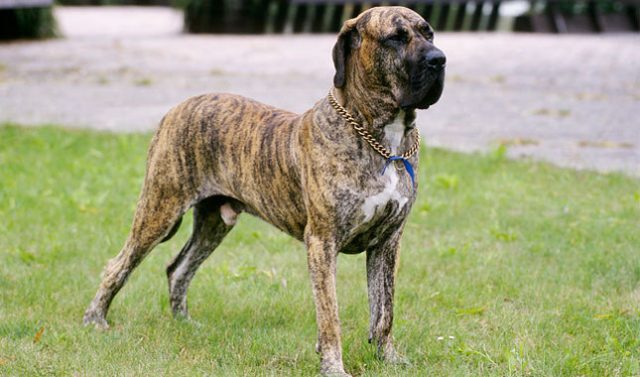Type the name of the breed you're looking for below
[wpdreams_ajaxsearchlite] Don't see the breed your're looking for? Click here and let us know!
Breed Characteristics
1 paw - breed exhibits the least amount of this characteristic
5 paws - breed exhibits most amount of this characteristic
Fila Brasileiro
| Other Names | Brazilian Mastiff, Brazilian Molosser, Cão de Fila |
| Nicknames | Fila |
| Country of Origin | Brazil |
| Weight | 90 - 110 lbs. (41 - 50 kg) |
| Height (at withers) | 25.5 - 29.5 in. (65 - 75 cm) |
| Coat | The coat is short, smooth, dense and soft. |
| Colour | This breed may be any colour, solid or brindle, except white, mouse gray, patched, dappled, or black and tan. The typical colours are fawn, black and brindle. Brindles of a basic colour may have the stripes of either less or with very strong intensity. A black mask may or may not be present. In all permitted colours white markings should be limited to the feet, chest and tip of tail. The white markings are not desirable on any other part of the body. |
| Litter Size | 2 - 5 puppies |
| Life Span | 9 - 11 years |
| Origin & History | The Fila Brasileiro is a descendant of the 15th-century English mastiff, bloodhound, bulldog and rafeiros. Its bloodhound ancestry being evident in its long muzzle and pendulous skin. The Fila Brasileiro is believed to have been evolved from a number of breeds,the Mastiff, the Bulldog, Bloodhound & The Rafeiro do Alentejo. The Fila Brasileiro breed was bred and raised primarily on large plantations and cattle farms where they were originated. They were taught to chase down jaguars, cattle, and other animals, as well as runaway slaves. The dogs would grab the slave or animals by the neck and hold them until the farmer arrived. This instinct can be observed among puppies when they are playing. The first written standard of the breed was edited in 1946. The Paulistas were responsible for organization a planned breeding program, opening a stud book to register dogs. Dr. Paulo Santos Cruz, began to systematically breed the Fila Brasileiro and also contributed largely in setting the CAFIB standard, and who now therefore, has the right to be called the "Father" of the Fila Brasileiro. About the registries, CBKC (Brazilian Confederation Kennel Club) follows the FCI (Federation Cynologique Internationale) policy and accepts for registration only dogs with FCI pedigrees, orienting the breeders to make a hip dysplasia control and besides other health problems. The Fila Brasileiro is described as a Brazilian Mastiff or a Brazilian Molosser. In the U.S., the OFA (Orthopedic Foundation for Animals) does a statistical registry of all Filas that were x-rayed to diagnose hip dysplasia. The Brazilian army compared this breed to Doberman Pinschers and German Shepherds in a five year study using these dogs in the jungle under extremely hostile conditions. The following traits were observed: intelligence, aggressiveness, sensibility, temperament, energy, resistance, rusticity and strength. German Shepherds were found to have the highest intelligence and Doberman Pinschers the highest level of aggression. The Fila Brasileiro was found to be superior in every other category. |
| Personality | The Brazilian Mastiffs are known to be naturally protective. It is also known for its extreme wariness of strangers and agility when protecting or defending its master. The dedication and obedience of the Fila Brasileiro has found its way into Brazilian saying "As faithful as a Fila" The Fila Brasileiro temperament is what characterizes the dog. The Portuguese word for their temperament is Ojeriza; which directly translated into English means dislike and distrust. The socialization period (about the first year with the first 6- 8 months being the most important) of the dog's life is crucial to the temperament of the individual dog. If the pup is exposed to a lot of people in a positive manner (known as 'socializing'), the pup (keeping in mind the dog's natural protective instincts) can be encouraged to behave in a calm manner in public, but emphasis should be placed on the fact that socialization is done differently from other breeds. Despite extensive socialization, the fila is instinctively protective and will naturally guard and protect its owner, their family members and the family pets; this is not something that needs to be trained, it is an innate trait. Strangers should not be left unattended with a fila and, like all other guardian breeds, it may not be the best choice for those who have frequent visitors to their homes. Lack of all socialization with strangers at a young age will result in a dog which is very anti-social. |
Care Requirements
| Health | Brazilian Mastiffs are prone to large breed ailments, including Hip Dysplasia, Gastric Torsion and Elbow Dysplasia. The dogs are often prone to bloat or gastric volvulus distension. |
| Grooming | The smooth, shorthaired coat is easy to groom. Brush with a firm bristle brush and wipe over with a piece of toweling or chamois for a gleaming finish. Bathe or dry shampoo when necessary. This breed is an average shedder. |
| Exercise | The Fila needs plenty of chance to exercise. While some can appear to be very lazy, big couch potatoes, like all dogs, they should be taken on daily walks. |
| Other Considerations | This breed is not suited to city life, as its vigorous body must work off energy in the freedom of the country. It needs a fenced-in yard with room to run. The Fila can sleep outdoors with proper shelter. |



